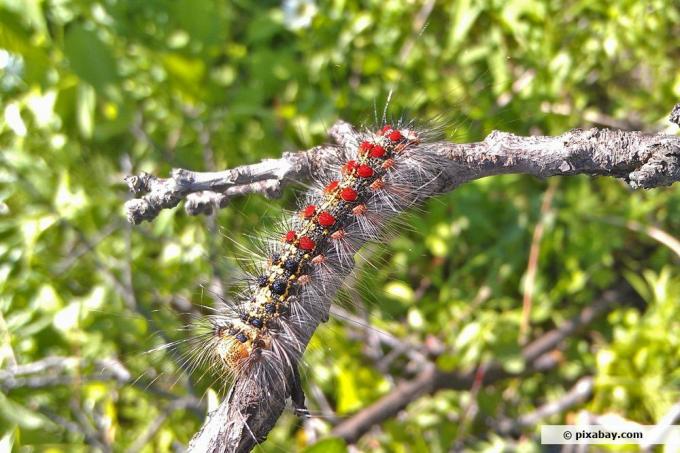
table of contents
- The gypsy moth
- Recognize
- Damage image
- Fight gypsy moth
- Prevent
- Promote natural enemies
Bare forest areas and front gardens, black house facades - that is the work of the gypsy moth. The moth caterpillar is currently invading the south and east of Germany in particular. And turns into a real nuisance. We clarify the most important questions: How dangerous is Lymantria dispar - the scientific name - for humans and nature? Is it even poisonous? And above all: How do I get rid of it?
The gypsy moth
The Research Institute for Forest, Snow and Landscape (WSL) speaks of a "major social problem" and indeed it does For a few weeks now, there has been a picture in Franconia, Thuringia and parts of northern Saxony that can easily be taken from the Bible could. Because like the locusts in the past, millions of gypsy moth caterpillars are now attacking houses and gardens in the affected areas.
Infestation with the voracious pests is actually not a new phenomenon. Warm and dry early summer regularly cause the population to skyrocket. The extent to which the whole thing is assuming this year is nevertheless extraordinary. And in doing so - coupled with the aggressiveness of the caterpillars - leaves many garden and house owners in despair. Because: There is no real aid in sight.
But one after the other. First of all, we will give you some information briefly and succinctly on how to identify the insect and its damage.
Recognize
- Moth of the family of the owl butterflies (Noctuidae)
- Bearded Moth (Lymantriinae)
- Females significantly larger than males
- Eggs are preferably laid on deciduous trees
- young black caterpillars with long hairs
- partial formation of stinging hairs
- red and blue colored warts in older specimens
- female caterpillars 6 to 8 cm long
- male caterpillars 4 to 5 cm
Damage image
- move to hatch in the treetops
- Pitting in young leaves
- Consume whole leaves as you age
- complete defoliation in case of mass infestation
- Focus on fruit trees, oaks and hornbeams
- End of feeding time with the beginning of the calendar summer
- infested trees usually turn green again
- Exception: previously damaged / weakened oaks
- Post-migration from forest properties to residential areas is possible
- there during the day hidden from predators (on house walls and gutters)
- Eating in the cover of twilight
- not poisonous
- low allergy potential (reddening of the skin on sensitive areas on contact)
Fight gypsy moth
Unfortunately, there isn't much you can do about it. Because the use of insecticides to fight the insect on a chemical basis is off the table in all affected municipalities as of June 2019.
The reason: possible damage to other living beings cannot be ruled out one hundred percent. The use of pesticides may harm the environment more than it actually benefits. “Others would insects in broadband because it doesn't have a specific effect, ”says Konrad Nickschick, a specialist environmental service provider for the city of Gera, on behalf of the company.
The fact that pest populations often recover from the use of chemical agents faster than their enemies also makes those responsible hesitate. In addition, the larvae are already in the fourth larval stage shortly before pupation. "We hope that it will be over in two to three weeks", Nickschick continues. For the coming year, however, a preventive use of a pesticide is being discussed in order to prevent mass reproduction at an early stage.
So there are currently little or no options left for those affected to get rid of the gypsy moth caterpillars. In some areas, fly screens have been distributed to prevent people from entering houses and apartments. In addition, professional pest controllers are also on duty in many places to provide “first aid”. Children or people with an increased allergy potential should also avoid direct skin contact with the stinging hairs of the caterpillar.
tip: It is essential to keep all windows in the affected areas, especially on the upper floors, tightly closed.

Prevent
Furthermore, WSL recommends the following measures to private gardeners to prevent future mass reproduction:
- Give as few opportunities for pupation as possible
- Mechanically destroy caterpillars, pupae, butterflies, clutches (e. B. Rinsing with a water jet / high-pressure cleaner, collecting egg clusters)
- Catch the caterpillars in jute sacks or with glue traps
Promote natural enemies
The best, because it is most natural, solution to regulate the gypsy moth population in an ecological way is to use its predators. These include, among others:
- Large pupa predator (Calosoma sycophanta)
- Caterpillar flies (Tachinidae)
- Brackish wasps (Braconidae)
- Stink bugs (Pentatomidae)
- Fur beetle (Dermestidae)
- Soft beetles (Cantharidae)
- Ants
- Toads
- Lizards
- Birds (titmouse, golden cockerel, cuckoo)
- Mice and shrews

sources
https://www.mdr.de/brisant/ratgeber/schwammspinner-invasion-was-tun-gegen-den-raupenbefall-100.html
https://www.spiegel.de/wissenschaft/natur/schwammspinner-raupenplage-in-gunzenhausen-und-gera-a-1272945.html
https://www.dora.lib4ri.ch/wsl/islandora/object/wsl%3A9120/datastream/PDF/view




